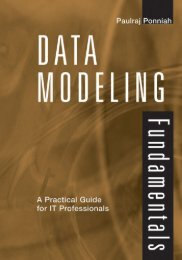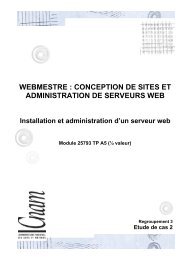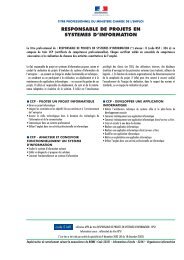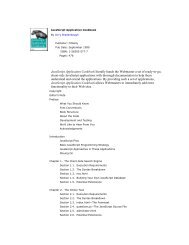- Page 1:
The EXPERT’s VOIce ® in Web Deve
- Page 4 and 5:
Pro JavaScript Design Patterns Cop
- Page 7:
Contents at a Glance About the Auth
- Page 10 and 11:
viii ■CONTENTS ■CHAPTER 3 Encap
- Page 12 and 13:
x ■CONTENTS ■CHAPTER 8 The Brid
- Page 14 and 15:
xii ■CONTENTS Example: Tooltip Ob
- Page 17:
About the Authors ■ROSS HARMES is
- Page 21:
Acknowledgments Thanks to our intre
- Page 24 and 25:
xxii ■INTRODUCTION them. This typ
- Page 26 and 27:
xxiv ■INTRODUCTION behaviors on m
- Page 28 and 29:
xxvi ■INTRODUCTION • extend(sub
- Page 31 and 32:
CHAPTER 1 ■ ■ ■ Expressive Ja
- Page 33 and 34:
CHAPTER 1 ■ EXPRESSIVE JAVASCRIPT
- Page 35 and 36:
CHAPTER 1 ■ EXPRESSIVE JAVASCRIPT
- Page 37 and 38:
CHAPTER 1 ■ EXPRESSIVE JAVASCRIPT
- Page 39 and 40:
CHAPTER 2 ■ ■ ■ Interfaces Th
- Page 41 and 42:
CHAPTER 2 ■ INTERFACES 13 Java us
- Page 43 and 44:
CHAPTER 2 ■ INTERFACES 15 /* inte
- Page 45 and 46:
CHAPTER 2 ■ INTERFACES 17 } if(!i
- Page 47 and 48:
CHAPTER 2 ■ INTERFACES 19 The Int
- Page 49 and 50:
CHAPTER 2 ■ INTERFACES 21 1. Incl
- Page 51:
CHAPTER 2 ■ INTERFACES 23 Pattern
- Page 54 and 55:
26 CHAPTER 3 ■ ENCAPSULATION AND
- Page 56 and 57:
28 CHAPTER 3 ■ ENCAPSULATION AND
- Page 58 and 59:
30 CHAPTER 3 ■ ENCAPSULATION AND
- Page 60 and 61:
32 CHAPTER 3 ■ ENCAPSULATION AND
- Page 62 and 63:
34 CHAPTER 3 ■ ENCAPSULATION AND
- Page 64 and 65:
36 CHAPTER 3 ■ ENCAPSULATION AND
- Page 66 and 67:
38 CHAPTER 3 ■ ENCAPSULATION AND
- Page 68 and 69:
40 CHAPTER 3 ■ ENCAPSULATION AND
- Page 70 and 71:
42 CHAPTER 4 ■ INHERITANCE Classi
- Page 72 and 73:
44 CHAPTER 4 ■ INHERITANCE having
- Page 74 and 75:
46 CHAPTER 4 ■ INHERITANCE Instea
- Page 76 and 77:
48 CHAPTER 4 ■ INHERITANCE var co
- Page 78 and 79:
50 CHAPTER 4 ■ INHERITANCE It is
- Page 80 and 81:
52 CHAPTER 4 ■ INHERITANCE Exampl
- Page 82 and 83:
54 CHAPTER 4 ■ INHERITANCE To cre
- Page 84 and 85:
56 CHAPTER 4 ■ INHERITANCE this.s
- Page 86 and 87:
58 CHAPTER 4 ■ INHERITANCE this.f
- Page 88 and 89:
60 CHAPTER 4 ■ INHERITANCE this.s
- Page 90 and 91:
62 CHAPTER 4 ■ INHERITANCE this.s
- Page 93 and 94:
CHAPTER 5 ■ ■ ■ The Singleton
- Page 95 and 96:
CHAPTER 5 ■ THE SINGLETON PATTERN
- Page 97 and 98:
CHAPTER 5 ■ THE SINGLETON PATTERN
- Page 99 and 100:
CHAPTER 5 ■ THE SINGLETON PATTERN
- Page 101 and 102:
CHAPTER 5 ■ THE SINGLETON PATTERN
- Page 103 and 104: CHAPTER 5 ■ THE SINGLETON PATTERN
- Page 105 and 106: CHAPTER 5 ■ THE SINGLETON PATTERN
- Page 107 and 108: CHAPTER 5 ■ THE SINGLETON PATTERN
- Page 109 and 110: CHAPTER 5 ■ THE SINGLETON PATTERN
- Page 111 and 112: CHAPTER 6 ■ ■ ■ Chaining In t
- Page 113 and 114: CHAPTER 6 ■ CHAINING 85 Since all
- Page 115 and 116: CHAPTER 6 ■ CHAINING 87 (function
- Page 117 and 118: CHAPTER 6 ■ CHAINING 89 Using Cal
- Page 119: PART 2 ■ ■ ■ Design Patterns
- Page 122 and 123: 94 CHAPTER 7 ■ THE FACTORY PATTER
- Page 124 and 125: 96 CHAPTER 7 ■ THE FACTORY PATTER
- Page 126 and 127: 98 CHAPTER 7 ■ THE FACTORY PATTER
- Page 128 and 129: 100 CHAPTER 7 ■ THE FACTORY PATTE
- Page 130 and 131: 102 CHAPTER 7 ■ THE FACTORY PATTE
- Page 132 and 133: 104 CHAPTER 7 ■ THE FACTORY PATTE
- Page 134 and 135: 106 CHAPTER 7 ■ THE FACTORY PATTE
- Page 136 and 137: 108 CHAPTER 7 ■ THE FACTORY PATTE
- Page 138 and 139: 110 CHAPTER 8 ■ THE BRIDGE PATTER
- Page 140 and 141: 112 CHAPTER 8 ■ THE BRIDGE PATTER
- Page 142 and 143: 114 CHAPTER 8 ■ THE BRIDGE PATTER
- Page 144 and 145: 116 CHAPTER 8 ■ THE BRIDGE PATTER
- Page 146 and 147: 118 CHAPTER 8 ■ THE BRIDGE PATTER
- Page 148 and 149: 120 CHAPTER 8 ■ THE BRIDGE PATTER
- Page 150 and 151: 122 CHAPTER 8 ■ THE BRIDGE PATTER
- Page 153: CHAPTER 9 ■ ■ ■ The Composite
- Page 157 and 158: CHAPTER 9 ■ THE COMPOSITE PATTERN
- Page 159 and 160: CHAPTER 9 ■ THE COMPOSITE PATTERN
- Page 161 and 162: CHAPTER 9 ■ THE COMPOSITE PATTERN
- Page 163 and 164: CHAPTER 9 ■ THE COMPOSITE PATTERN
- Page 165 and 166: CHAPTER 9 ■ THE COMPOSITE PATTERN
- Page 167 and 168: CHAPTER 9 ■ THE COMPOSITE PATTERN
- Page 169 and 170: CHAPTER 10 ■ ■ ■ The Facade P
- Page 171 and 172: CHAPTER 10 ■ THE FACADE PATTERN 1
- Page 173 and 174: CHAPTER 10 ■ THE FACADE PATTERN 1
- Page 175 and 176: CHAPTER 10 ■ THE FACADE PATTERN 1
- Page 177 and 178: CHAPTER 11 ■ ■ ■ The Adapter
- Page 179 and 180: CHAPTER 11 ■ THE ADAPTER PATTERN
- Page 181 and 182: asyncRequest: function() { function
- Page 183 and 184: CHAPTER 11 ■ THE ADAPTER PATTERN
- Page 185 and 186: CHAPTER 11 ■ THE ADAPTER PATTERN
- Page 187 and 188: CHAPTER 12 ■ ■ ■ The Decorato
- Page 189 and 190: CHAPTER 12 ■ THE DECORATOR PATTER
- Page 191 and 192: CHAPTER 12 ■ THE DECORATOR PATTER
- Page 193 and 194: CHAPTER 12 ■ THE DECORATOR PATTER
- Page 195 and 196: CHAPTER 12 ■ THE DECORATOR PATTER
- Page 197 and 198: CHAPTER 12 ■ THE DECORATOR PATTER
- Page 199 and 200: CHAPTER 12 ■ THE DECORATOR PATTER
- Page 201 and 202: CHAPTER 12 ■ THE DECORATOR PATTER
- Page 203 and 204: CHAPTER 12 ■ THE DECORATOR PATTER
- Page 205:
CHAPTER 12 ■ THE DECORATOR PATTER
- Page 208 and 209:
180 CHAPTER 13 ■ THE FLYWEIGHT PA
- Page 210 and 211:
182 CHAPTER 13 ■ THE FLYWEIGHT PA
- Page 212 and 213:
184 CHAPTER 13 ■ THE FLYWEIGHT PA
- Page 214 and 215:
186 CHAPTER 13 ■ THE FLYWEIGHT PA
- Page 216 and 217:
188 CHAPTER 13 ■ THE FLYWEIGHT PA
- Page 218 and 219:
190 CHAPTER 13 ■ THE FLYWEIGHT PA
- Page 220 and 221:
192 CHAPTER 13 ■ THE FLYWEIGHT PA
- Page 222 and 223:
194 CHAPTER 13 ■ THE FLYWEIGHT PA
- Page 225 and 226:
CHAPTER 14 ■ ■ ■ The Proxy Pa
- Page 227 and 228:
CHAPTER 14 ■ THE PROXY PATTERN 19
- Page 229 and 230:
CHAPTER 14 ■ THE PROXY PATTERN 20
- Page 231 and 232:
CHAPTER 14 ■ THE PROXY PATTERN 20
- Page 233 and 234:
CHAPTER 14 ■ THE PROXY PATTERN 20
- Page 235 and 236:
CHAPTER 14 ■ THE PROXY PATTERN 20
- Page 237 and 238:
CHAPTER 14 ■ THE PROXY PATTERN 20
- Page 239 and 240:
CHAPTER 14 ■ THE PROXY PATTERN 21
- Page 241 and 242:
CHAPTER 14 ■ THE PROXY PATTERN 21
- Page 243 and 244:
CHAPTER 15 ■ ■ ■ The Observer
- Page 245 and 246:
CHAPTER 15 ■ THE OBSERVER PATTERN
- Page 247 and 248:
CHAPTER 15 ■ THE OBSERVER PATTERN
- Page 249 and 250:
CHAPTER 15 ■ THE OBSERVER PATTERN
- Page 251:
CHAPTER 15 ■ THE OBSERVER PATTERN
- Page 254 and 255:
226 CHAPTER 16 ■ THE COMMAND PATT
- Page 256 and 257:
228 CHAPTER 16 ■ THE COMMAND PATT
- Page 258 and 259:
230 CHAPTER 16 ■ THE COMMAND PATT
- Page 260 and 261:
232 CHAPTER 16 ■ THE COMMAND PATT
- Page 262 and 263:
234 CHAPTER 16 ■ THE COMMAND PATT
- Page 264 and 265:
236 CHAPTER 16 ■ THE COMMAND PATT
- Page 266 and 267:
238 CHAPTER 16 ■ THE COMMAND PATT
- Page 268 and 269:
240 CHAPTER 16 ■ THE COMMAND PATT
- Page 270 and 271:
242 CHAPTER 16 ■ THE COMMAND PATT
- Page 272 and 273:
244 CHAPTER 16 ■ THE COMMAND PATT
- Page 274 and 275:
246 CHAPTER 17 ■ THE CHAIN OF RES
- Page 276 and 277:
248 CHAPTER 17 ■ THE CHAIN OF RES
- Page 278 and 279:
250 CHAPTER 17 ■ THE CHAIN OF RES
- Page 280 and 281:
252 CHAPTER 17 ■ THE CHAIN OF RES
- Page 282 and 283:
254 CHAPTER 17 ■ THE CHAIN OF RES
- Page 284 and 285:
256 CHAPTER 17 ■ THE CHAIN OF RES
- Page 286 and 287:
258 CHAPTER 17 ■ THE CHAIN OF RES
- Page 288 and 289:
260 CHAPTER 17 ■ THE CHAIN OF RES
- Page 290 and 291:
262 CHAPTER 17 ■ THE CHAIN OF RES
- Page 292 and 293:
264 ■INDEX classical inheritance,
- Page 294 and 295:
266 ■INDEX as objects, 6-8, 37 pr
- Page 296 and 297:
268 ■INDEX performance issues, 12
- Page 298:
Offer valid through 06/08.











